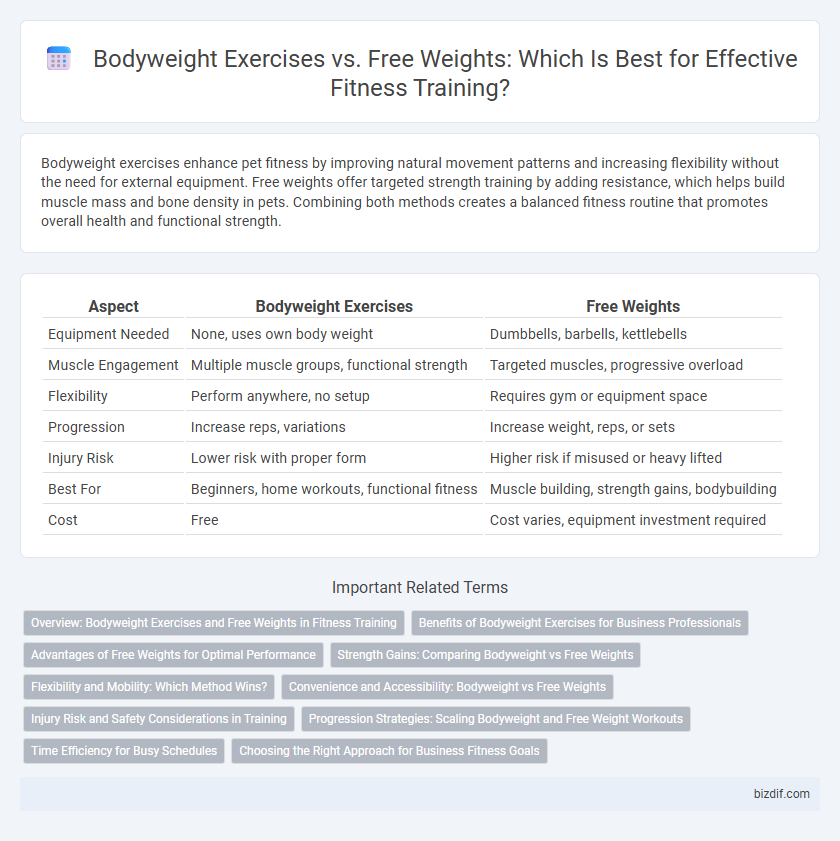Bodyweight exercises enhance pet fitness by improving natural movement patterns and increasing flexibility without the need for external equipment. Free weights offer targeted strength training by adding resistance, which helps build muscle mass and bone density in pets. Combining both methods creates a balanced fitness routine that promotes overall health and functional strength.
Table of Comparison
| Aspect | Bodyweight Exercises | Free Weights |
|---|---|---|
| Equipment Needed | None, uses own body weight | Dumbbells, barbells, kettlebells |
| Muscle Engagement | Multiple muscle groups, functional strength | Targeted muscles, progressive overload |
| Flexibility | Perform anywhere, no setup | Requires gym or equipment space |
| Progression | Increase reps, variations | Increase weight, reps, or sets |
| Injury Risk | Lower risk with proper form | Higher risk if misused or heavy lifted |
| Best For | Beginners, home workouts, functional fitness | Muscle building, strength gains, bodybuilding |
| Cost | Free | Cost varies, equipment investment required |
Overview: Bodyweight Exercises and Free Weights in Fitness Training
Bodyweight exercises leverage an individual's own weight to build strength, improve flexibility, and enhance muscular endurance without requiring any equipment. Free weights, including dumbbells and barbells, provide adjustable resistance that targets specific muscle groups and allows progressive overload for muscle growth. Both methods offer unique benefits in fitness training, with bodyweight exercises excelling in portability and functional strength, while free weights optimize controlled resistance and muscle isolation.
Benefits of Bodyweight Exercises for Business Professionals
Bodyweight exercises enhance functional strength and improve flexibility without requiring gym equipment, making them ideal for busy business professionals. These workouts can be performed anywhere, facilitating consistency despite hectic schedules and frequent travel. Improved core stability and posture from regular bodyweight routines also reduce work-related discomfort and boost overall productivity.
Advantages of Free Weights for Optimal Performance
Free weights offer superior versatility and allow for a full range of motion, promoting functional strength and muscle coordination essential for complex, compound movements. They enable progressive overload more effectively by allowing precise weight adjustments, which accelerates muscle hypertrophy and strength gains. Free weights also engage stabilizer muscles intensively, improving balance, joint stability, and overall athletic performance.
Strength Gains: Comparing Bodyweight vs Free Weights
Bodyweight exercises enhance strength by utilizing the individual's own mass, promoting functional movement and muscle endurance with minimal equipment. Free weights offer adjustable resistance, enabling targeted muscle hypertrophy and progressive overload for significant strength gains. Combining both methods optimizes overall muscular development, balance, and stability in strength training programs.
Flexibility and Mobility: Which Method Wins?
Bodyweight exercises enhance flexibility and mobility by promoting natural movement patterns and dynamic stretching through full range of motion activities like yoga and calisthenics. Free weights primarily build strength and muscle mass but can limit flexibility gains if performed with restricted range movements and improper form. For optimal mobility improvements, incorporating bodyweight training ensures joint health and functional flexibility while free weights complement by providing resistance for strength without compromising movement quality.
Convenience and Accessibility: Bodyweight vs Free Weights
Bodyweight exercises offer unmatched convenience and accessibility, requiring no special equipment and allowing workouts anywhere, anytime. Free weights demand a dedicated space and investment in equipment, often limiting portability and spontaneous training opportunities. For individuals seeking flexibility and immediate access, bodyweight workouts provide a practical solution over free weights.
Injury Risk and Safety Considerations in Training
Bodyweight exercises generally offer a lower injury risk compared to free weights due to controlled movement patterns and reduced load on joints, making them safer for beginners and those with limited mobility. Free weights provide greater strength gains but require proper technique and supervision to prevent strain, especially in lifting heavy loads or performing complex movements like deadlifts and squats. Incorporating proper warm-up, form monitoring, and gradual progression in both training modalities significantly minimizes injury potential and enhances long-term safety during fitness routines.
Progression Strategies: Scaling Bodyweight and Free Weight Workouts
Progression strategies for bodyweight exercises involve increasing repetitions, altering leverage, or incorporating advanced variations like plyometrics to enhance strength and endurance. Free weight workouts progress through incremental load increases, adjusting volume, and varying exercise complexity to promote muscle hypertrophy and power. Structured progression ensures continuous adaptation by systematically challenging muscles while minimizing injury risk.
Time Efficiency for Busy Schedules
Bodyweight exercises maximize time efficiency by eliminating the need for equipment setup and gym visits, making them ideal for busy schedules. Free weights often require more preparation and space but provide greater resistance variety and muscle targeting for effective strength gains. Choosing bodyweight workouts allows quick, full-body training sessions that fit easily into tight daily routines.
Choosing the Right Approach for Business Fitness Goals
Bodyweight exercises offer scalable resistance and portability, making them ideal for clients seeking functional strength and flexibility without equipment costs. Free weights provide precise load management and muscle isolation, enhancing hypertrophy and strength gains crucial for bodybuilding or performance-focused goals. Selecting the right approach depends on aligning exercise modality with specific business fitness objectives, client needs, and available resources.
Bodyweight Exercises vs Free Weights Infographic

 bizdif.com
bizdif.com